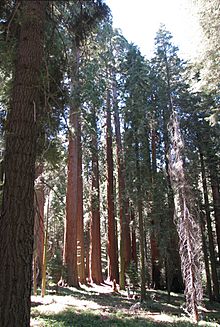Muir Grove facts for kids
Quick facts for kids Muir Grove |
|
|---|---|

Muir Grove
|
|
| Map | |

Map of Muir Grove within Sequoia National Park
|
|
| Geography | |
| Location | Sequoia National Park, California, United States |
| Coordinates | 36°37′53″N 118°50′10″W / 36.63139°N 118.83611°W |
| Elevation | 6,293 ft (1,918 m) |
| Area | 215 acres (0.87 km2) |
| Ecology | |
| Dominant tree species | Sequoiadendron giganteum |
Muir Grove is a special place found in Sequoia National Park in California. It's a beautiful forest that covers about 215 acres (0.87 square kilometers). This grove is home to amazing giant sequoia trees, which are some of the biggest trees on Earth!
You can find Muir Grove in the northwest part of the park. To get there, you follow the Muir Grove Trail, which starts near the Dorst Creek Campground. Because it's a bit harder to reach, fewer people visit this grove. This helps keep Muir Grove quiet, natural, and well-preserved.
History of Muir Grove
Muir Grove is named after a very important person: John Muir. He was a Scottish-American writer and a great lover of nature. John Muir worked hard to protect wild places in the United States.
His writings and efforts helped convince many people and politicians to save natural areas. Thanks to his work, places like Sequoia National Park were created. He played a big part in making sure these beautiful forests would be protected for everyone to enjoy.
Trees and Plants of the Grove
Muir Grove is filled with many different kinds of trees. There are about 629 cone-bearing trees in total. While it's a bit harder for new giant sequoia trees to grow here, there are already many huge, old sequoia trees standing tall. This means the grove has lots of mature trees, even if fewer young ones are sprouting up.
The most common tree in Muir Grove is the white fir. There are 523 white fir trees, making up 83% of all the trees here. Another important tree is the sugar pine, with 71 trees. Of course, the famous giant sequoias are also here, with 33 amazing specimens. You can also find incense cedars growing in drier, rocky spots.
The ground in Muir Grove is often moist, which helps many smaller plants grow. There are 56 different kinds of plants covering the ground. Only a small part of the land, about 16%, doesn't have any plants growing on it. Some of the plants you might see include chinquapin, hazelnut, and Pacific dogwood.
Muir Grove Trail Adventure
The Muir Grove Trail is a hike that's about 4.2 miles (6.8 kilometers) long. You'll climb about 530 feet (162 meters) in elevation. The trail starts at the Dorst Creek Campground. You walk west for about 1.9 miles (3.1 kilometers) to reach the edge of the old-growth sequoia grove.
Not many people take the time to hike this trail to see the giant sequoias. Along the trail itself, you won't see many sequoias right away. But you will enjoy beautiful Sierra woodland scenery. The path goes past two creeks, through pine forests, and among other large trees. When you finally reach Muir Grove, the trail ends, and you'll find yourself surrounded by many giant sequoias. It feels like a quiet, special place.


